A Vision on a UNESCO Global Geopark at the Southeastern Dead Sea in Jordan—Geosites and Conceptual Approach
Abstract
1. Introduction
1.1. The State of Tourism in Jordan—A Potential for Geotourism
1.2. The Dead Sea and Its Surroundings
2. Objectives, Performed and Anticipated Methods
3. Results: Background, Geosites and Concepts for the Aspiring Geopark
3.1. Extent and Infrastructure of the Geopark
3.2. Regional Climate
3.3. Geology of the Proposed UGGp Territory
3.4. Geologic and Archaeologic Heritage of International Significance
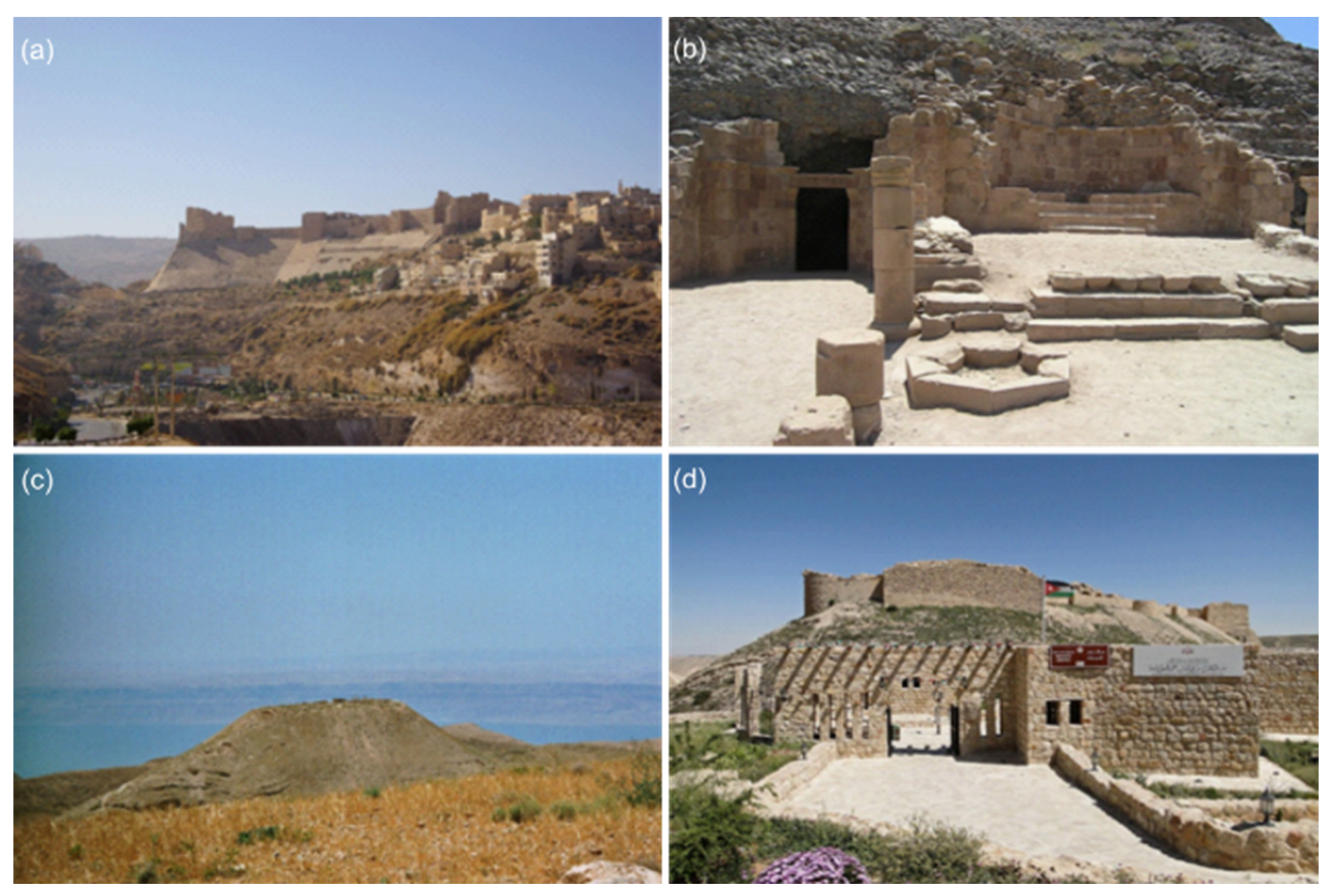
3.5. Socioeconomic Considerations
3.6. Potential Geotouristic Activity and Infrastructure
3.7. Implementation—From National Geopark to UNESCO Global Geopark
3.7.1. Realised Efforts
3.7.2. Timeline
- (1)
- Year 2022
- National Geopark Committee meetings and initial workshop 2022 with framework planning of finances, extent, and initial partners.
- Application to UNESCO grant for the Geopark initiation in Africa and the Middle East.
- Networking with other UNESCO Geoparks and possible partners: inhabitants, local stakeholders, politicians, scientific advisors, touristic agencies, NGOs.
- Looking for sponsors for different aspects of the aspiring Geopark–e.g., UNESCO support workshops and capacity building, USAID, UNICEF, KfW, SEG, GIZ, UNDP.
- Initialization of Scientific pre-surveys and activities (e.g., projects to monitor safe areas, cf. Section 3.7 and companion paper [5]).
- Artist project about sinkhole highlight area.
- White Paper/publication in MDPI–Land-SI Geoparks.
- Beginning of the geodiversity assessment
- (2)
- Years 2023–2024
- Grassroot initiatives to establish management, tourism, and maintenance structures.
- Participation of the Applicant in UNESCO Geopark workshops/schools.
- Legalization as National Jordanian Geopark.
- Beginning of Geodiversity Inventory with an evaluation of geotouristic potential.
- Beginning of promotion of the Geopark.
- Beginning of investment in infrastructure.
- Extension phases 2 and 3 (cf. Figure 3).
- Scientific activity and workshops on water management, educational activities, and infrastructure development.
- (3)
- Years 2025–2027
- Application to accredit the status of UNESCO Global Geopark.
- First outcome of the scientific activities (publications).
- Investments.
- UNESCO evaluation procedure, adaptation, possible re-application.
- (4)
- After 2027
- Continues adaptation with possible inclusion of other areas, new partners, investment, running, management and checks by UNESCO.
3.8. Planned Actitivities and Management
3.8.1. Eco-Tourism and Infrastructure
3.8.2. Education and Society
3.8.3. Science
3.8.4. Management and Maintenance
3.8.5. Promotion and Communication
4. Discussion
4.1. A Challenging Environment
4.2. Expected Costs and Financing
4.2.1. Tourism
4.2.2. Education
4.2.3. Science and Monitoring
4.2.4. Initialisation, Management and Maintenance
4.3. Potential Partners for the Sustainable Development of the Geopark
4.4. Expected Services and Benefits for the Country
4.4.1. International Recognition and Visibility
4.4.2. Education and Resilience on Water Resource Management, Hazards and Earthquakes
4.4.3. Economic Benefits to the Local Communities
4.4.4. At the Frontier to Research Advancements
4.4.5. Nature Protection and Geoconservation
4.5. Chances for Implementation and Restrictions to Be Considered
- There has been a previous application of the Wadi Mujib area for a UGGp. Integration of the (previous) area into the proposed larger Geopark area is sought and will be the solution to avoid conflicts. Initial communication has been established.
- There are dangerous zones (Figure 12) prone to collapse (sinkholes, cracks), sinking (mud) or drowning (lakes, ponds) and flash flood risk (wadis). Visit of such zones will only be possible by: (1) experienced guides, (2) during good weather, (3) only in the daytime, (4) with appropriate equipment and (5) along safe (elevated) routes. Therefore, hazard monitoring to define safe zones is an essential part of safeguarding certain areas of the Geopark. An approach is presented in the companion paper [5].
- During heavy rain events and days after, some parts of the territory will be closed for visitors. A hydrogeophysical monitoring group will be established and will supervise decisions and alarm plans for flash floods. See the companion paper [5].
- Parts of the former lakebed in the proposed zone are a military border area, and visitor permission may be needed
- The continuous regression of the lake will expose new flats and shorelines and may alter further the local climate. It would also need a continuous re-assessment and definition of walkways and points of interest.
- The effect of the progressing DS-Red Sea canal project is unclear concerning the chemistry of the Dead Sea and its evolution. This could be a focus bio-hydrochemistry scientific research project.
- A UGGp must respect local and national laws relating to the protection of geological heritage. The defining geological heritage sites within a UGGp must be legally protected in advance of any application.
- The Geopark’s financial sustainability is critical to its success and continuation. Strong local and international partnerships, and investments into infrastructure, along with revenue generated from tourism activities, will be required to assure the project’s long-term success.
5. Conclusions
Author Contributions
Funding
Institutional Review Board Statement
Informed Consent Statement
Data Availability Statement
Acknowledgments
Conflicts of Interest
References
- Farsani, N.T.; Coelho, C.; Costa, C. Geoparks and Geotourism: New Approaches to Sustainability for the 21st Century; Brown Walker Press: Boca Raton, FL, USA, 2011; ISBN 1612335519. [Google Scholar]
- UNESCO; IGGP; UGG. Statutes and Guidelines. Available online: http://www.unesco.org/new/fileadmin/MULTIMEDIA/HQ/SC/pdf/IGGP_UGG_Statutes_Guidelines_EN.pdf (accessed on 12 January 2022).
- GGN. Geopark Map-Global Network of National Geoparks. Available online: http://www.globalgeopark.org/GeoparkMap/index.htm (accessed on 20 January 2022).
- UNESCO. Global Geopark List. Available online: https://en.unesco.org/global-geoparks/list (accessed on 20 January 2022).
- Al-Halbouni, D.; Alrabayah, O.; Rüpke, L. A Vision on a UNESCO Global Geopark at the Southeastern Dead Sea in Jordan—How Natural Hazards May Offer Geotourism Opportunities. Under Rev. L. 2022. Available online: https://oceanrep.geomar.de/id/eprint/54899/ (accessed on 20 January 2022).
- Shahateet, M.; Partale, K. Jordan’s Tourism Sector Analysis and Strategy for Sectoral Improvement; Deutsche Gesellschaft für Internationale Zusammenarbeit (GIZ) GmbH: Bonn, Germany, 2019. [Google Scholar]
- MTA. Jordan Tourism Strategy 2021 to 2025. Ministry of Tourism and Antiquities 2021. Available online: Https://Procurement-Notices.Undp.Org (accessed on 9 February 2022).
- RSCN. The Royal Society for Conservation Nature Annual Report; RSCN: Jubaiha, Jordan, 2019. [Google Scholar]
- UNESCO. Key Facts and Figures on Jordan. Available online: https://en.unesco.org/system/files/countries/Home/jor_facts_figures.pdf (accessed on 20 January 2022).
- Allan, M. Geotourism in Jordan; The University of Jordan, Deanship of Academic Research: Amman, Jordan, 2014. [Google Scholar]
- Allan, M.; Dowling, R.; Sanders, D. The Motivations of Geotourists in Jordan. In Proceedings of the Third Global Geotourism Conference Tourism on a Plate: Seeing Destinations Differently, Muscat, Oman, 30 October–1 November 2011; Volume 30. [Google Scholar]
- Allan, M. Geotourism: An Opportunity to Enhance Geoethics and Boost Geoheritage Appreciation; Geology Society Special Publication: London, UK, 2015; Volume 419, pp. 25–29. [Google Scholar] [CrossRef]
- Dowling, R.; Allan, M. Who Are Geotourists? A Case Study from Jordan. In Handbook of Geotourism; Dowling, R., Newsome, D., Eds.; Edward Elgar Publishing: Cheltenham, UK, 2018; pp. 76–86. ISBN 9781785368851. [Google Scholar]
- Wojtowicz, B.; Wojtowicz, P. The Prospects for the Development of Geotourism in the Area of the Wadi Rum Desert. J. Tour. Hosp. Manag. 2016, 4, 1–14. [Google Scholar] [CrossRef][Green Version]
- Dowling, R.K. Geotourism’s Global Growth. Geoheritage 2011, 3, 1–13. [Google Scholar] [CrossRef]
- UNESCO. Wadi Mujib UNESCO Proposal. Available online: https://en.unesco.org/Sites/Default/Files/Unesco_global_geopark_intergovernmental_check_2020_english-Mujib.pdf (accessed on 28 March 2022).
- MEMR Geological Parks By-Law No. 21, 2021. Ministry of Energy and Mineral Resources. Available online: https://www.memr.gov.jo/Ebv4.0/Root_storage/Ar/Eb_list_page/%D9%86%D8%B8%D8%A7%D9%85_%D8%A7%D9%84%D9%85%D8%AD%D9%85%D9%8A%D8%A7%D8%AA_%D8%A7%D9%84%D8%AC%D9%8A%D9%88%D9%84%D9%88%D8%AC%D9%8A%D8%A9_%D8%B1%D9%82%D9%85_(21)_%D9%84%D8%B3%D9%86%D8%A9_2021.pdf (accessed on 9 February 2022).
- MoEnv The National Climate Change Adaptation Plan of Jordan—Ministry of Environment 2021. Available online: http://www.moenv.gov.Jo/Ebv4.0/Root_storage/Ar/Eb_list_page/Final_draft_nap-2021.pdf (accessed on 31 March 2022).
- MEMR Jordan Prime Minister Elevates Climate Action Plan to National Priority—Ministry of Energy and Mineral Resources. Available online: http://www.moenv.gov.jo/EN//NewsDetails/JORDAN_PRIME_MINISTER_ELEVATES_CLIMATE_ACTION_PLAN_TO_NATIONAL_PRIORITY (accessed on 10 February 2022).
- Levy, Y.; Shalev, E.; Burg, A.; Yechieli, Y.; Gvirtzman, H. Three-Dimensional Configuration and Dynamics of the Fresh—Saline Water Interface near Two Saline Lakes with Different Levels (Middle East). Hydrogeol. J. 2021, 29, 1785–1795. [Google Scholar] [CrossRef]
- ICL. Dead Sea Water Level—ICL. Available online: https://icl-group-sustainability.com/reports/dead-sea-water-level/ (accessed on 13 January 2022).
- Gavrieli, I.; Stein, M. On the Origin and Fate of the Brines in the Dead Sea Basin. In New Frontiers in Dead Sea Paleoenvironmental Research; Geology Society America: Boulder, CO, USA, 2006; Volume 401, pp. 183–194. [Google Scholar]
- Yechieli, Y.; Reznik, I.J.; Tal, A.; Netzer, L.; Livshitz, Y.; Stein, S. General Information and Hydrogeology of the Mediterranean and Dead Sea Coastal Aquifers and Their Relation with Their Base Level. In The Many Facets of Israel’s Hydrogeology; Springer: Cham, Switzerland, 2021; pp. 31–48. [Google Scholar]
- Al Kuisi, M.; Abed, A.M.; Mashal, K.; Saffarini, G.; Saqhour, F. Hydrogeochemistry of Groundwater from Karstic Limestone Aquifer Highlighting Arsenic Contamination: Case Study from Jordan. Arab. J. Geosci. 2015, 8, 9699–9720. [Google Scholar] [CrossRef]
- Salameh, E. The Hydrogeological Consequences of the Proposed Extraction of the Deep Groundwater in Jordan. J. Geosci. Environ. Prot. 2021, 9, 111–128. [Google Scholar] [CrossRef]
- Ababsa, M. Atlas of Jordan; Ababsa, M., Ed.; Institutes Francais du Proche Orient: Beyrouth, Lebanon, 2013; ISBN 9782351593783. [Google Scholar]
- Nissenbaum, A. The Dead Sea—An Economic Resource for 10 000 Years. Hydrobiologia 1993, 267, 127–141. [Google Scholar] [CrossRef]
- USGS. Landsat Images from USGS. Available online: https://earthshots.usgs.gov/earthshots/ (accessed on 20 January 2022).
- ArcGIS. World Imagery Database. Available online: https://www.arcgis.com/home/item.html?id=10df2279f9684e4a9f6a7f08febac2a9 (accessed on 31 March 2022).
- Willner, S.E.; Lipchin, C.; Aloni, Z. Salt Storms, Sinkholes and Major Economic Losses: Can the Deteriorating Dead Sea Be Saved from the Looming Eco Crisis? Negev. Dead Sea Arav. Stud. 2015, 7, 27–37. [Google Scholar]
- Abou Karaki, N.; Fiaschi, S.; Closson, D. Sustainable Development and Anthropogenic Induced Geomorphic Hazards in Subsiding Areas. Earth Surf. Process. Landf. 2016, 41, 2282–2295. [Google Scholar] [CrossRef]
- Al-Halbouni, D.; Holohan, E.P.; Saberi, L.; Alrshdan, H.; Sawarieh, A.; Closson, D.; Walter, T.R.; Dahm, T. Sinkholes, Subsidence and Subrosion on the Eastern Shore of the Dead Sea as Revealed by a Close-Range Photogrammetric Survey. Geomorphology 2017, 285, 305–324. [Google Scholar] [CrossRef]
- Ezersky, M.G.; Legchenko, A.; Eppelbaum, L.; Al-Zoubi, A.S. Overview of the Geophysical Studies in the Dead Sea Coastal Area Related to Evaporite Karst and Recent Sinkhole Development. Int. J. Speleol. 2017, 46, 277–302. [Google Scholar] [CrossRef]
- Shviro, M.; Haviv, I.; Baer, G.G. High-Resolution InSAR Constraints on Flood-Related Subsidence and Evaporite Dissolution along the Dead Sea Shores: Interplay between Hydrology and Rheology. Geomorphology 2017, 293, 53–68. [Google Scholar] [CrossRef]
- Abou Karaki, N.; Fiaschi, S.; Paenen, K.; Al-Awabdeh, M.; Closson, D. Exposure of Tourism Development to Salt Karst Hazards along the Jordanian Dead Sea Shore. Hydrol. Earth Syst. Sci. 2019, 23, 2111–2127. [Google Scholar] [CrossRef]
- Khodayar, S.; Hoerner, J. An Idealized Model Sensitivity Study on Dead Sea Desertification with a Focus on the Impact on Convection. Atmos. Chem. Phys. 2020, 20, 12011–12031. [Google Scholar] [CrossRef]
- TG Flash Flood in Jordan Sweeps Away School Bus, Killing at Least 18, The Guardian. Available online: https://www.theguardian.com/world/2018/oct/25/flash-flood-in-jordan-sweeps-away-school-bus-killing-children (accessed on 5 January 2022).
- Closson, D.; Hansen, H.; Halgand, F.; Milisavljevic, N.; Hallot, F.; Acheroy, M. The Red Sea–Dead Sea Canal: Its Origin and the Challenges It Faces. In Macro-Engineering Seawater in Unique Environments; Badescu, V., Cathcart, R.B., Eds.; Environmental Science and Engineering; Springer: Berlin/Heidelberg, Germany, 2011; pp. 107–124. ISBN 978-3-642-14778-4. [Google Scholar]
- GOJ. Jordan Red Sea Project Description; Government of Jordan: Amman, Jordan, 2011; Available online: Https://Www.Scribd.Com/Document/96081097/JRSP-Project-Description (accessed on 9 February 2022).
- El-Anis, I.; Smith, R. Freshwater Security, Conflict, and Cooperation: The Case of the Red Sea-Dead Sea Conduit Project. J. Dev. Soc. 2013, 29, 1–22. [Google Scholar] [CrossRef]
- JT. 5 Alliances Shortlisted to Execute Red-Dead’s Phase I. Available online: http://www.jordantimes.com/news/local/5-alliances-shortlisted-execute-red-dead’s-phase-i (accessed on 12 January 2022).
- JT. Water Ministry Proceeds with Amman-Aqaba Water Desalination Project. Available online: https://www.jordantimes.com/news/local/water-ministry-proceeds-amman-aqaba-water-desalination-project (accessed on 12 January 2022).
- UN Transforming Our World: The 2030 Agenda for Sustainable Development. United Nations. Gen. Assem. Resolut. A/RES/70/1 2015. Available online: Https://Sustainabledevelopment.Un.Org (accessed on 9 February 2022).
- Putayeva, E. Different Approaches to the Formation of Geoparks. Acta Geoturistica 2014, 5, 69–80. [Google Scholar] [CrossRef]
- Jose, B. Geoconservation and Protected Areas. Environ. Conserv. 2002, 29, 273–276. [Google Scholar] [CrossRef]
- Union for the Mediterranean. Jordanian Railway Network. 2017. Available online: https://ufmsecretariat.org./Wp-Content/Uploads/2017/12/TUD-Jordanian-Railway_EN.pdf (accessed on 9 February 2022).
- Worldbank Jordan—Climatology. Available online: https://climateknowledgeportal.worldbank.org/country/jordan/climate-data-historical (accessed on 5 January 2022).
- Bender, F. Geology of Jordan; Schweizerbart’sche Verlagsbuchhandlung: Stuttgart, Germany, 1974. [Google Scholar]
- Pollastro, R.M.; Karshbaum, A.S.; Viger, R.J. Maps Showing Geology, Oil and Gas Fields and Geologic Provinces of the Arabian Peninsula; U.S. Geological Survey Open-File Report 97-470-B; U.S. Geological Survey: Reston, VA, USA, 1999; 14p. [Google Scholar]
- Garfunkel, Z.; Ben-Avraham, Z. The Structure of the Dead Sea Basin. Tectonophysics 1996, 266, 155–176. [Google Scholar] [CrossRef]
- El-Hasan, T.; Abu-Jaber, N. Geochemistry, Mineralogy and Origin of the Shallow Water Sediments Collected along the Eastern Shore of the Northern Part of the Dead Sea. Carbonates Evaporites 2018, 34, 975–985. [Google Scholar] [CrossRef]
- Khoury, H.N. Clays and Clay Minerals in Jordan; Deanship of Scientific Research: Amman, Jordan, 2002. [Google Scholar]
- Garber, R.A.; Friedman, G.M. The Sedimentology of the Dead Sea. Carbonates Evaporites 1987, 2, 43–57. [Google Scholar] [CrossRef]
- Kerp, H.; Blomenkemper, P.; Hamad, A.A.B.U.; Bomfleur, B. The Fossil Flora of the Dead Sea Region, Jordan—A Late Permian Garden of Delights. J. Palaeosci. 2021, 70, 135–158. [Google Scholar]
- Kumaraswamy, P.R. The Palgrave Handbook of the Hashemite Kingdom of Jordan; Springer: Berlin/Heidelberg, Germany, 2019; ISBN 9811391661. [Google Scholar]
- Clark, G.A.; Coinman, N.R.; Hill, J.B.; Neeley, M.P.; Olszewski, D.I.; Peterson, J.D.; Schuldenrein, J. Survey and Excavation of Stone Age Sites in Jordan’s Wadi Al-Hasa: 1979–2012. In Quaternary of the Levant: Environments, Climate Change, and Humans; Bar-Yosef, O., Enzel, Y., Eds.; Cambridge University Press: Cambridge, UK, 2017; pp. 315–328. ISBN 9781107090460. [Google Scholar]
- Werner, B. Al Karak Castle. Available online: https://upload.wikimedia.org/wikipedia/commons/0/08/Kerak_BW_1.JPG (accessed on 31 March 2022).
- Al’ain, A. Sanctuary of Lot. Available online: https://de.m.wikipedia.org/wiki/Datei:Sanctuary_of_Lot_02.jpg (accessed on 31 March 2022).
- Thomas Bantle Machaerus Panorama. Available online: https://upload.wikimedia.org/wikipedia/commons/b/b2/Machaerus_Panorama.jpg (accessed on 31 March 2022).
- Gagnon, B. Montreal Castle. Available online: https://upload.wikimedia.org/wikipedia/commons/6/65/Montreal_Castle_Visitor_center.jpg (accessed on 31 March 2022).
- Ryan, C.R. Hashemite Kingdom of Jordan. In The Government and Politics of the Middle East and North Africa; Yom, S.L., Gasiorowski, M., Eds.; Westview Press: Boulder, CO, USA, 2017. [Google Scholar]
- WPR. Population of Cities in Jordan, World Population Review. Available online: https://worldpopulationreview.com/countries/cities/jordan (accessed on 5 January 2022).
- El-Naqa, A. Hydrological and Hydrogeological Characteristics of Wadi El Mujib Catchment Area, Jordan. Environ. Geol. 1993, 22, 257–271. [Google Scholar] [CrossRef]
- Al-Halbouni, D.; Alrabayah, O.; Rüpke, L. Vision on a UNESCO Global Geopark at the Southeastern Dead Sea, Jordan. In Proceedings of the Digital 9th International Conference on UNESCO Global Geoparks, GGN, Jeju Island, Korea, 12–16 December 2021. [Google Scholar]
- Costa, M.P.; Meneses, S.; Nunes, J.C. Geo-Urban Routes as a Powerful and Easily Available Educational Resource—Case of Angra Do Heroísmo City in Azores UGGp. In Proceedings of the Digital 9th International Conference on UNESCO Global Geoparks, Jeju Island, Korea, 12–16 December 2021. [Google Scholar]
- Martins, J.S.; Pintalssilgo, A.; Mories, A.; Araújo, A.; Veiga-Pires, C. Geopalcos: Art, Science and Nature as Instruments of Cohesion and Promotion of the Aspiring Geopark Algarvensis Territory. In Proceedings of the Digital 9th International Conference on UNESCO Global Geoparks, Jeju Island, Korea, 12–16 December 2021. [Google Scholar]
- Sá, A.A.; Rosado-González, E.; Silva, E. Five Years of the UNESCO Chair on Geoparks, Regional Sustainable Development, and Healthy Lifestyles—Changing the World Through Education. In Proceedings of the Digital 9th International Conference on UNESCO Global Geoparks, Jeju Island, Korea, 12–16 December 2021. [Google Scholar]
- Goyanes, G.; Vieira, G.; Soncco, C.; De Castro, E. 3D Modelling Of Geosites—From Surveying To Outreach. In Proceedings of the Digital 9th International Conference on UNESCO Global Geoparks, Jeju Island, Korea, 12–16 December 2021. [Google Scholar]
- Soncco, C.; Vieira, G.; Goyanes, G.; De Castro, E. Ultra-High Resolution Maps and Models as Tools for Managing and Monitoring Environmentally Sensitive Geosites (Estrela Geopark, Portugal). In Proceedings of the Digital 9th International Conference on UNESCO Global Geoparks, Jeju Island, Korea, 12–16 December 2021. [Google Scholar]
- Al-Halbouni, D.; Watson, R.A.; Holohan, E.P.; Meyer, R.; Polom, U.; Santos, F.M.; Comas, X.; Alrshdan, H.; Krawczyk, C.M.; Dahm, T. Dynamics of Hydrological and Geomorphological Processes in Evaporite Karst at the Eastern Dead Sea—A Multidisciplinary Study. Hydrol. Earth Syst. Sci. 2021, 25, 3351–3395. [Google Scholar] [CrossRef]
- Williams, M.A.; McHenry, M.T. Tasmanian Reserve Geoconservation Inventory Assessment Using Geographic Information Technology (GIT). Int. J. Geoheritage Park. 2021, 9, 294–312. [Google Scholar] [CrossRef]
- Kitsaki, G.; Papaioannou, H. New Technologies in the Service and Promotion of Geological, Natural and Cultural Heritage. In Proceedings of the Digital 9th International Conference on UNESCO Global Geoparks, Jeju Island, Korea, 12–16 December 2021. [Google Scholar]
- Williams, M.A.; McHenry, M.T. The Increasing Need for Geographical Information Technology (GIT) Tools in Geoconservation and Geotourism. Geoconserv. Res. 2020, 3, 17–32. [Google Scholar] [CrossRef]
- Rodrigues, J.; Duarte, A.; Costa, M.P.; Morais, A.; Castro, E. Geotourism Strategy in Portuguese UNESCO Global Geoparks. In Proceedings of the Digital 9th International Conference on UNESCO Global Geoparks, Jeju Island, Korea, 12–16 December 2021. [Google Scholar]
- Oliveira, S.; Moura, D.; Pereira, L.; Veiga-Pires, C. Promoting Geosites In The Community—The Escarpão Plateau (South of Portugal). In Proceedings of the Digital 9th International Conference on UNESCO Global Geoparks, Jeju Island, Korea, 12–16 December 2021. [Google Scholar]
- Lugeri, F.R.; Farabollini, P.; Greco, R.; Amadio, V. The Geological Characterization of Landscape in Major TV Series: A Suggested Approach to Involve the Public in the Geological Heritage Promotion. Sustainability 2015, 7, 4100–4119. [Google Scholar] [CrossRef]
- Department of Statistics. Jordan Statistical Yearbook 2020; DoS: Amman, Jordan, 2021.
- World Bank Population Growth Indicator 2021. Available online: https://data.worldbank.org/indicator/SP.POP.GROW?end=2020&locations=JO&start=1961&view=chart (accessed on 9 February 2022).
- Kumaraswamy, P.R.; Singh, M. Population Pressure in Jordan and the Role of Syrian Refugees. Migr. Dev. 2017, 6, 412–427. [Google Scholar] [CrossRef]
- Salameh, E.; Al-Ansari, N. Deficient Developmental Planning Leading to Water Conflicts across Political Borders: The Way Forward. Engineering 2021, 13, 158–172. [Google Scholar] [CrossRef]
- Brückner, F.; Bahls, R.; Alqadi, M.; Lindenmaier, F.; Hamdan, I.; Alhiyari, M.; Atieh, A. Causes and Consequences of Long-Term Groundwater Overabstraction in Jordan. Hydrogeol. J. 2021, 29, 2789–2802. [Google Scholar] [CrossRef]
- Al-Ansari, N.; Alibrahiem, N.; Alsaman, M.; Knutsson, S. Water Demand Management in Jordan. Engineering 2014, 6, 19–26. [Google Scholar] [CrossRef]
- Fallatah, O.A.; Ahmed, M.; Save, H.; Akanda, A.S. Quantifying Temporal Variations in Water Resources of a Vulnerable Middle Eastern Transboundary Aquifer System. Hydrol. Process. 2017, 31, 4081–4091. [Google Scholar] [CrossRef]
- Salameh, E.; Shteiwi, M.; Al Raggad, M. Water Resources of Jordan: Political, Social and Economic Implications of Scarce Water Resources; Springer: Berlin/Heidelberg, Germany, 2018; Volume 1, ISBN 3319777483. [Google Scholar]
- Loureiro, F.; Castro, E. Geoconservation in the Estrela UNESCO Global Geopark. In Proceedings of the Digital 9th International Conference on UNESCO Global Geoparks, Jeju Island, Korea, 12–16 December 2021. [Google Scholar]
- Skibiński, J.; Kultys, K.; Baran-Zgłobicka, B.; Zgłobicki, W. Geoparks in SE Poland as Areas of Tourism Development: Current State and Future Prospects. Resources 2021, 10, 113. [Google Scholar] [CrossRef]
- Williams, M.A.; McHenry, M.T.; Boothroyd, A. Geoconservation and Geotourism: Challenges and Unifying Themes. Geoheritage 2020, 12, 63. [Google Scholar] [CrossRef]
- MEMR. Oil & Gas Exploration Opportunities in Jordan; Ministry of Energy and Mineral Resources: Amman, Jordan, 2021.
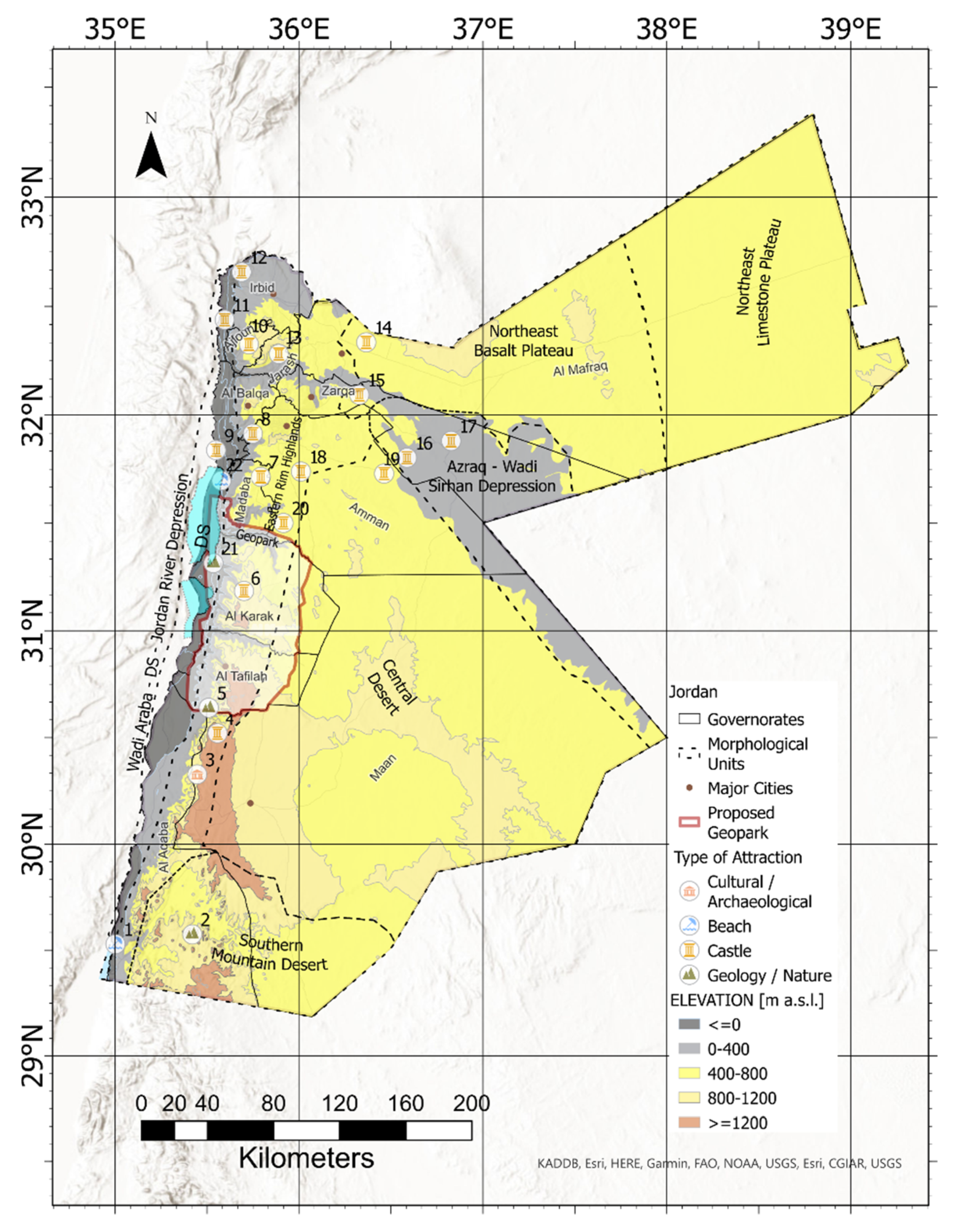

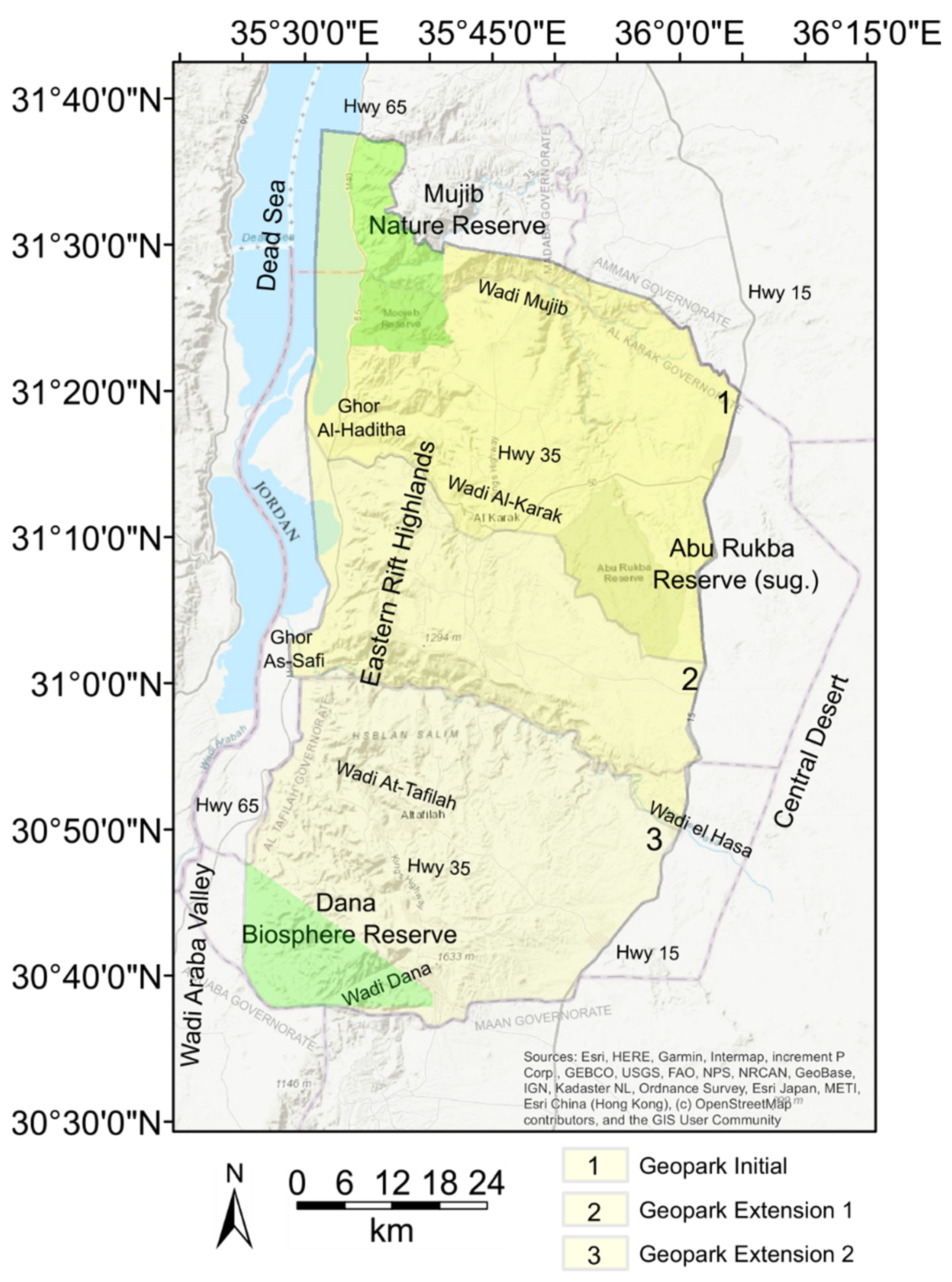


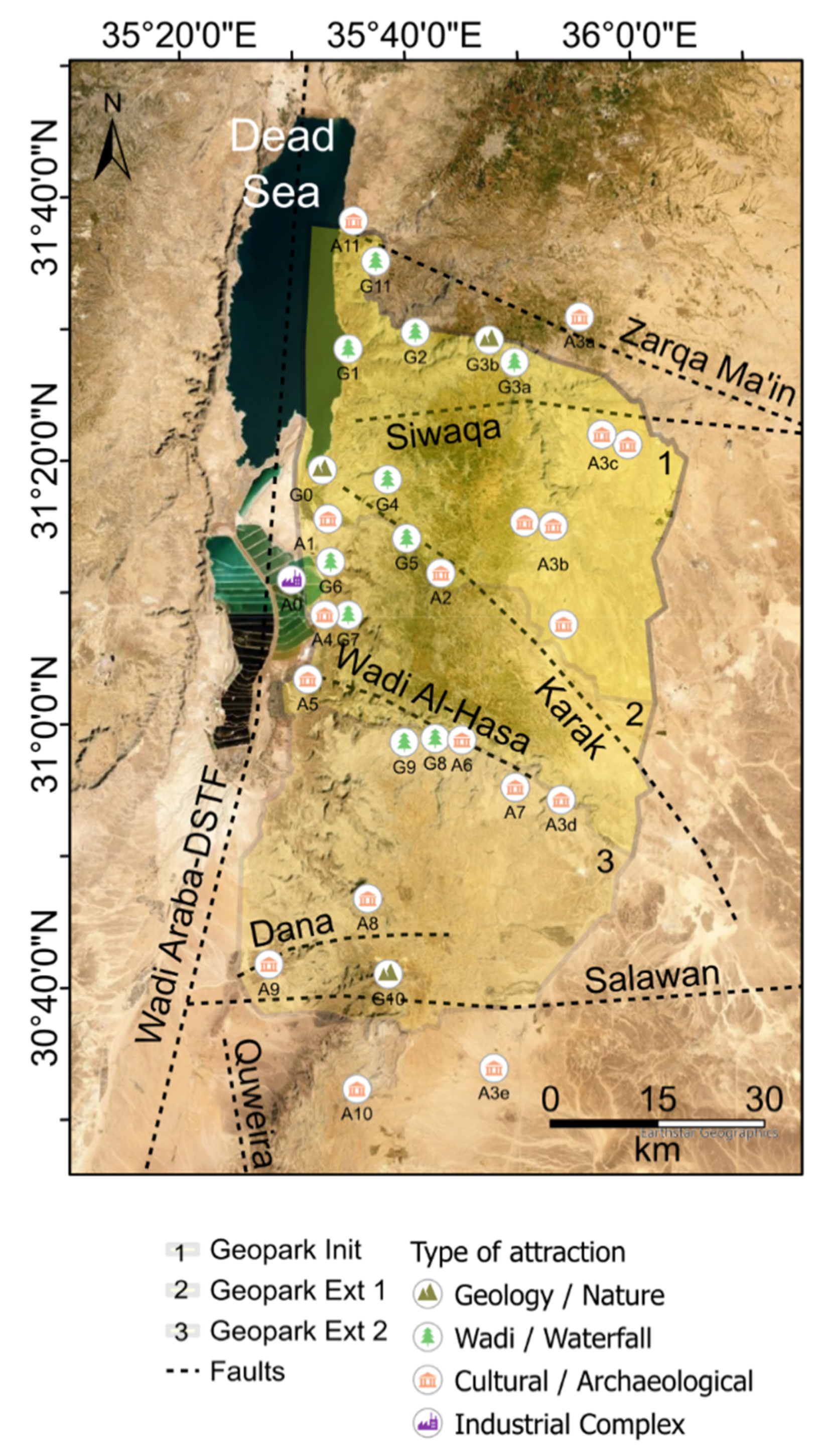


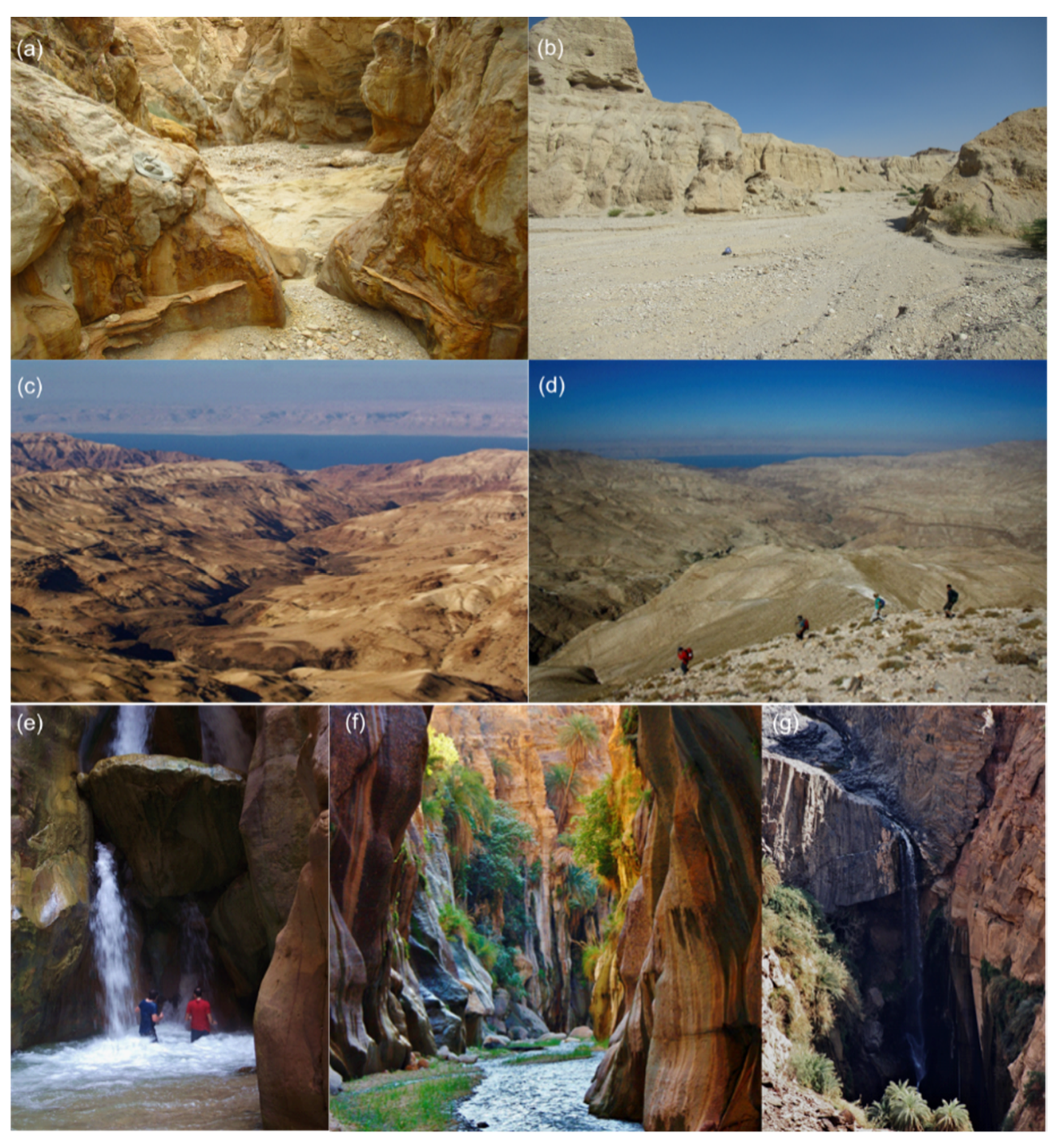
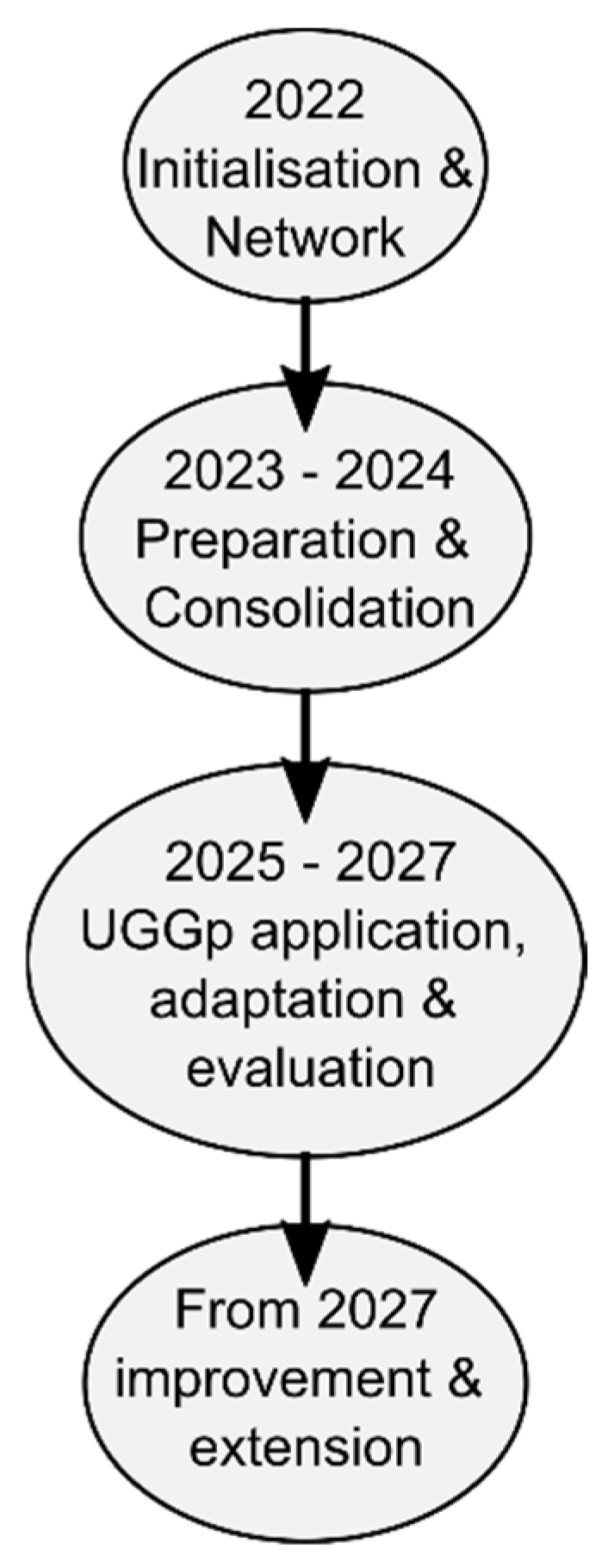
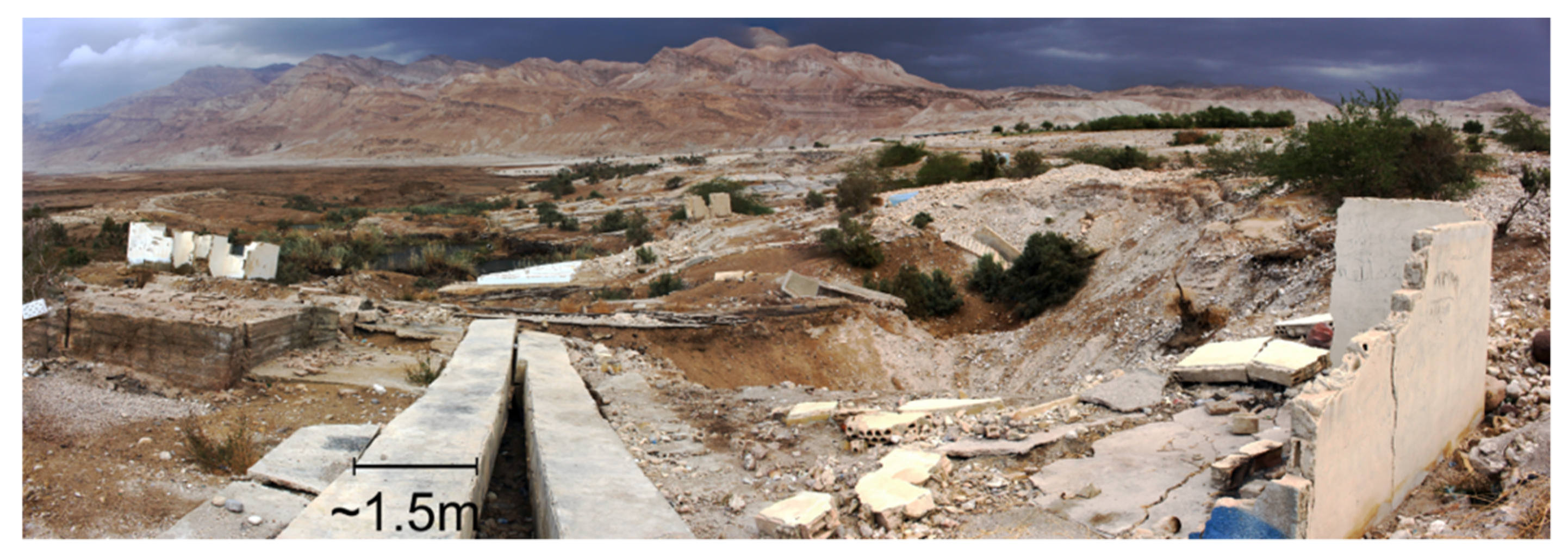
| Geological/Ecological (G) | Short Description | Archaeological/Cultural (A) | Short Description |
|---|---|---|---|
| G0 | Highlight area–sinkholes and subsidence at Ghor Al-Haditha, Dead Sea shoreline | A0 | Evaporation ponds–Arab Potash Factory |
| G1 | Wadi Mujib Reserve and waterfalls | A1 | Bab edh-Dhra archaeological site of Bronze Age, Wadi Al-Hasa |
| G2 | Wadi Mujib canyon up to the plateau (Wadi Hidan/Waleh) | A2 | Al-Karak, historical city and archaeological remains (crusader castle) |
| G3a, b | Wadi Mujib canyon (a) up to the plateau (dam, b) Western Highlands range mountains, valleys and springs | A3a–e | Limes Arabicus–archaeological remains of roman origin, i.e., Umm Al-Rasas (a), Betthorus (b), Quasr Abu Rukba (b), Khirbet el-Fityan (b), Rujm el-Faridiyyeh (b), Quasr Bshir (c), Qasr Abu el-Kharaq (c), Umm Ubtulah (d), and Qasr Dajaniya (e). |
| G4 | Wadi Ibn Hamad and hot springs | A4 | Numeira archaeological site of Bronze Age |
| G5 | Wadi Mutayl/Al Karak and Mumia falls | A5 | Ghor As-Safi museum of the lowest place on Earth, Lot’s Cave byzantine basilica |
| G6 | Wadi Assal | A6 | Khirbet et-Tannur archaeological remains of Nabatean origin |
| G7 | Wadi Numeira | A7 | Khirbet ed-Dharih archaeological remains of Nabatean origin |
| G8 | Wadi Al-Hasa | A8 | At-Tafilah historical city and Sela castle from Edom kingdom |
| G9 | Afra hot springs | A9 | Khirbat en-Nahas Bronze age copper mine |
| G10 | Wadi Dana and Dana Biosphere Reserve | A10 | Shobak crusader castle-Montreal |
| G11 | Wadi Ma’in Hot springs | A11 | Dead Sea Panoramic Complex |
| West | Centre | East | Outside |
|---|---|---|---|
| Ghor Al-Haditha | Al-Mughayer | Al-Quatrana | Shobak |
| Ghor Al-Mazra’a | Al-Karak | Jurf Ed-Darawish | Dhiban |
| Ghor As-Safi | At-Tafilah | Hasa | Al-Husainya |
| Feifa | Dana | ||
| Al-Qasr |
| Site Name | Area | Information | Activities |
|---|---|---|---|
| Mujib Adventure Centre | Dead Sea | The RSCN runs and manages the centre, which provides visitors with information on the Mujib biosphere reserve, including its geological history. The facility also offers a range of tourism activities. | Hiking, accommodations, local crafts, and educational programs. |
| Alhidan Adventures Centre | Madaba | The RSCN manages the property, which is administered by the local community. The facility offers a variety of hiking paths in the Mujib biosphere reserve’s western region. | Hiking tours. |
| Alhidan Camp Site | Madaba | The property is owned and operated by the local community and is located on the eastern outskirts of the Mujib Biosphere Reserve. | Accommodation. |
| Al Numeira Environmental Association | Ghor Al-Mazra’a | The association is operated and administered by local communities in the region, with the goal of addressing environmental issues and encouraging a more sustainable way of life in the Southern Ghor region. The Association provides various tourism activities and lodging in order to generate sustainable revenue for the association and to provide jobs for the local populations. | Educational programs, local crafts, biking, and hiking tours. |
| Shallalat Mumia Cooperative Society | Al-Karak | The Society offers a variety of tourism activities in Wadi Al-Karak as a means of generating income, creating jobs, and capacity building in the local communities. | Hiking tours, accommodation, and educational programs. |
| Feynan Ecolodge | Wadi Araba | The lodge is privately operated, and it offers a variety of tourism activities in the Dana Reserve’s western region. The lodge employs people from the surrounding area. | Hiking tours accommodation and educational programs. |
| No | Name | Focus |
|---|---|---|
| 1 | Jordan Tourism Board (JTB) | Utilize marketing strategies to brand, position and promote the Jordan tourism product as the destination of choice in the international markets. This can facilitate the promotion of the Geopark as a unique tourism destination. |
| 2 | Jordanian Ministry of Tourism and Antiquities | To promote and develop tourism and to invest in tourism resources in order to increase its contribution to supporting the national economy and spreading understanding among people. The ministry will be an essential partner for the development and promotion of tourism activities within the Geopark. |
| 3 | Ministry of Environment (MoEnv) | The ministry’s core role is protecting and sustaining the environment and all of its components, including air, water, and soil, through developing legal, strategic and policy frameworks in addition to spreading environmental culture and enhancing environmental monitoring and law enforcement in Jordan. The ministry will be the main partner for the development of a conservation and protection plan for the Geopark. |
| 4 | The Jordan Valley Authority (JVA) | As part of the Ministry of Water and Irrigation (MWI), JVA is concerned with the management and development of water resources and land in the Jordan Valley including the Southern Ghor region. |
| 5 | Local municipality, and educational directorate of Al-Karak, Altafileh and Madaba | Promoting educational activities within the Geopark and facilitating the work and implementation of the laws within the area. |
| 6 | Royal Society for the Conservation of Nature (RSCN) | Nature protection and the establishment and management of nature reserves. Implementation of the protection program and the law of hunting. The RSCN are managing the conservation and tourism activities in Dana Biosphere Reserve, Fifa Nature Reserve and Mujib Nature Reserve. |
| 7 | Jordan Trail Association (JTA) | The association aim to develop and maintain the Jordan trail (a long-distance hiking trail that crosses Jordan north most to south most and passes through different regions within the proposed Geopark) and to support and build the capacity of local communities that the trail passes through. |
| No | Name | Focus |
|---|---|---|
| 6 | Al Numeira Environmental Association | Promote water conservation and sustainable living in the Dead Sea area by educating the local community about environmental issues. The Association operates a small visitor centre in Ghor Al-Numeira. |
| 7 | Dana Cooperative | The cooperative’s goals include the preservation of Dana village, community development, and the empowerment of local women and youth. The cooperative aims at creating community-owned, sustainable tourism in Dana Nature Reserve. |
| 8 | Mumia Falls Cooperative Organisation | The Organisation aims to develop environmental tourism, support the economic style of the local community, enhance its ownership of its resources, and harness its traditional knowledge for the service of residents and visitors at Wadi Al-Karak area. |
| 9 | Al-Karak Creativity Club | The club is involved in the development and promotion of ecotourism within Al-Karak governorate. |
| 10 | Rakin Women’s Society | Women’s empowerment through increased economic engagement in Wadi Ibn Hammad area. The Society operates a number of revenue-generating tourism projects. |
| 11 | Other | Private persons, companies, (e.g., Arab Potash Factory) and other touristic initiatives (e.g., cultech.net) |
Publisher’s Note: MDPI stays neutral with regard to jurisdictional claims in published maps and institutional affiliations. |
© 2022 by the authors. Licensee MDPI, Basel, Switzerland. This article is an open access article distributed under the terms and conditions of the Creative Commons Attribution (CC BY) license (https://creativecommons.org/licenses/by/4.0/).
Share and Cite
Al-Halbouni, D.; AlRabayah, O.; Rüpke, L. A Vision on a UNESCO Global Geopark at the Southeastern Dead Sea in Jordan—Geosites and Conceptual Approach. Land 2022, 11, 549. https://doi.org/10.3390/land11040549
Al-Halbouni D, AlRabayah O, Rüpke L. A Vision on a UNESCO Global Geopark at the Southeastern Dead Sea in Jordan—Geosites and Conceptual Approach. Land. 2022; 11(4):549. https://doi.org/10.3390/land11040549
Chicago/Turabian StyleAl-Halbouni, Djamil, Osama AlRabayah, and Lars Rüpke. 2022. "A Vision on a UNESCO Global Geopark at the Southeastern Dead Sea in Jordan—Geosites and Conceptual Approach" Land 11, no. 4: 549. https://doi.org/10.3390/land11040549
APA StyleAl-Halbouni, D., AlRabayah, O., & Rüpke, L. (2022). A Vision on a UNESCO Global Geopark at the Southeastern Dead Sea in Jordan—Geosites and Conceptual Approach. Land, 11(4), 549. https://doi.org/10.3390/land11040549







